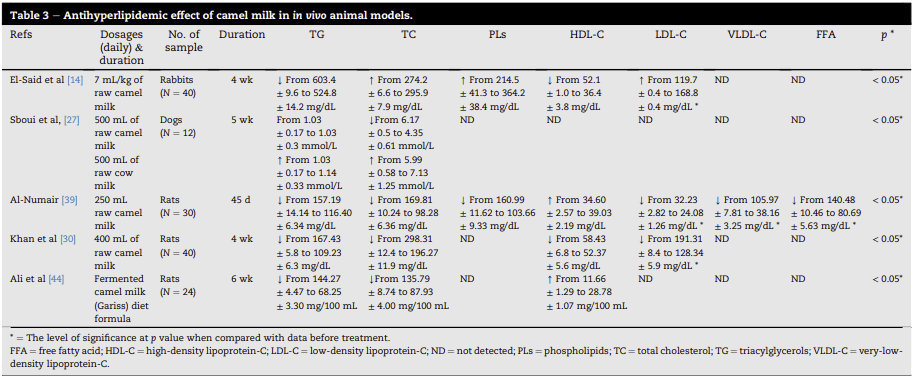3. ANTIHYPERLIPIDEMIC EFFECT OF CAMEL MILK
Diabetes is associated with profound variations in plasma lipids, triglycerides, and lipoprotein profile, and is responsible for vascular complications and an increased risk of heart disease . Thus, lowering the cholesterol levels through dietary or drug therapy seems to be associated with a reduced risk of heart disease . Low-density lipoprotein-C (LDL-C) in the human body circulation undergoes reuptake in the liver through
particular receptors and is thereby cleared from the circulation . The elevation of LDL levels in the plasma of diabetic patients can be the result of a defect in the LDL-C receptor (i.e., failure in production or function). High-density lipoprotein-C (HDL-C) is protective by reversing cholesterol transport, inhibiting the oxidation of LDL-C, and neutralizing the atherogenic effects of oxidized LDL-C . There is a correlation between the level of very-low-density lipoprotein-C (VLDL-C) and HDL-C. A significant increase in LDL-C and VLDL-C levels may lead to a significant decrease in HDL-C levels. In addition, lower HDL-C levels can also occur because of reduced activity in lecithin cholesterol acyltransferase (LCAT) [39]. A previous study shows that the administration of camel milk can help decrease the levels of cholesterol in diabetic patients .
In one study , alloxan-induced diabetic dogs treated with camel milk (Group 1) showed a statistically significant decrease (p < 0.05) in the total cholesterol (TC) level from 6.17 ± 0.15 mmol/L to 4.35 ± 0.61 mmol/L after 5 weeks. In this period, diabetic dogs treated with cow milk (Group 2) showed an increase in the TC level from 5.99 ± 0.58 mmol/L to 7.13 ± 1.25 mmol/L (Table 3) . However, the diabetic dogs in Group 2 were treated with camel milk instead of cow milk for the next 5 weeks, and showed a 30% improvement in the TC level. Furthermore, diabetic dogs from Group 1 showed an improvement in lipid profile even after 5 weeks of having stopped drinking camel milk . Al-Numair reported that the administration of camel milk is able to reduce hyperlipidemia that is associated with the risk of DM. This study found TC, triacylglycerols (TG), free fatty acid (FFA), phospholipids (PLs), LDL-C, and VLDL-C levels significantly decreased (p < 0.05) towards normal levels in plasma and tissues (e.g., liver, kidney, and heart), whereas the plasma HDL-C significantly improved in diabetic rats after treatment with camel milk for 45 days (Table 3). Another study conducted by El-Said et al to evaluate the effect of camel milk on lipid profile in experimentally induced diabetic rabbits was not in agreement with the previous study (Table 3). However, the group of diabetic rabbits treated with camel milk showed a significant (p < 0.05) reduction in the TG level from 603.4 ± 9.6 mg/dL to 524.8 ± 14.2 mg/dL after 1 month. To evaluate the protective role of camel milk against dyslipidemia, changes in the lipid profile levels were analyzed in STZ induced diabetic rats in one study [30]. The results of this study indicated that the levels of TC, TG, and LDL-C were significantly higher (p < 0.05) in the control group of diabetic rats and these levels were significantly reduced in the group of rats fed camel milk (Table 3). Other researchers recently studied the hypocholesterolemic effect of Gariss (i.e., fermented camel milk) on the levels of lipid profile of rats [44]. Table 2 They observed that TG, TC, HDL, and VLDLþLDL were

significantly reduced by 52%, 35.3%, 61%, and 53%, respectively, in a group of rats fed a cholesterol-enriched diet supplemented with Gariss for 6 weeks, compared to the control group fed only a cholesterol-enriched diet (Table 3).
An earlier study has shown that no significant changes occurred in the lipid profile after 3 months in diabetic patients (type 1) treated with camel milk . However, Agrawal et al found a significant reduction of LDL-C and TG in type 1 diabetic patients after being treated with camel milk for 6 months (Table 4). By contrast, no significant differences in TC, HDL-C, and VLDL levels were shown in diabetic patients after being treated with camel milk (Table 4). Mohamad et al showed the efficiency of camel milk as an adjuvant therapy on the lipid profile of young type 1 diabetic patients. The TC and TG level in type 1 diabetics decreased by 25% and 37%, respectively, after treatment with camel milk for 16 weeks; however, there were no significant differences in HDL, LDL, and VLDL levels after treatment [36]. El-Sayed et al investigated the effect of insulin provided by camel’s milk on the lipid profile of type 1 diabetics in comparison with insulin injection alone or camel milk alone. After 3 months, the lipid profile in the type 1 diabetic patients injected with insulin (i.e., the control group) decreased the levels of TG and TC by 9% and LDL-C by 7% (Table 4). The lipid profile conversely decreased significantly (p < 0.001) by three-fold for TG and by two-fold for TC and LDL-C in diabetic patients treated with camel milk (Table 4). The diabetic patient group treated with a mixture of insulin and camel milk showed a significant reduction (p < 0.001) in TG and TC (approximately 45%) and LDL-C (approximately 30%), compared to control. In addition, the HDL-C level increased significantly (p < 0.001) from 41 mg/ dL to 49 mg/dL in patients treated with the mixture.

Source: Science Direct
Comments

John Doe
23/3/2019Lorem ipsum dolor sit amet, consectetur adipisicing elit, sed do eiusmod tempor incididunt ut labore et dolore magna aliqua. Ut enim ad minim veniam, quis nostrud exercitation ullamco laboris nisi ut aliquip ex ea commodo consequat.

John Doe
23/3/2019Lorem ipsum dolor sit amet, consectetur adipisicing elit, sed do eiusmod tempor incididunt ut labore et dolore magna aliqua. Ut enim ad minim veniam, quis nostrud exercitation ullamco laboris nisi ut aliquip ex ea commodo consequat.

John Doe
23/3/2019Lorem ipsum dolor sit amet, consectetur adipisicing elit, sed do eiusmod tempor incididunt ut labore et dolore magna aliqua. Ut enim ad minim veniam, quis nostrud exercitation ullamco laboris nisi ut aliquip ex ea commodo consequat.